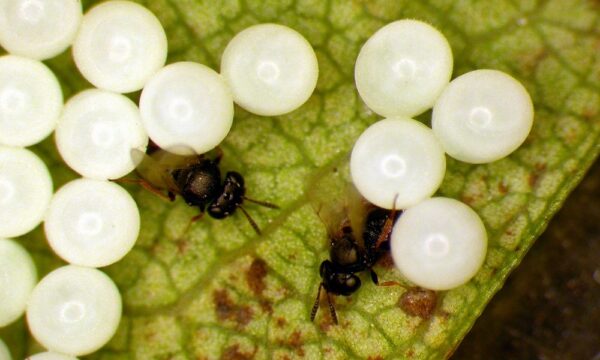By Urs Schaffner
Over the last few years, biological invasions have become a regular topic in the news. Today the general public is probably better informed about the negative environmental and economic impacts alien invasive species can cause than ever before. However, concern about invasive species and the search for methods to sustainably manage them has a much longer history, dating back to the 19th century.
One of the key approaches for managing invasive alien insect pests and weeds is the introduction of natural enemies from the native range of the target species to reduce the target species’ population densities. Introductions of invertebrate biological control agents (IBCAs) were primarily made in the context of classical biological control projects, which aim at establishing the IBCA and suppressing the target species permanently, but in a few cases releases were also made in inundative biological control projects, which aim at mass-rearing and repeatedly mass-releasing IBCAs in the invaded range.
Europe has been a major source for natural enemies used in biological control of invasive weeds and arthropods in other parts of the world. Yet, although sometimes overlooked, deliberate releases of exotic IBCAs in Europe have a long history as well. In 1976, David Greathead (former director of the ‘International Institute of Biological Control’,) published a comprehensive “Review of Biological Control in Western and Southern Europe”. Since then, numerous new IBCAs have been released into Europe. In parallel, increasing concern regarding the risks of releasing IBCAs has led to more stringent regulations for field release of exotic IBCAs in some European countries. A lack of harmonization of regulations among European countries is problematic since agents released in one country will not stop at the border.
Within the past 110 years, at least 176 IBCAs have been introduced into the environment in Europe for biological control of at least 59 insect pests and two weed species. The largest numbers of IBCAs introduced into Europe are reported from countries in the Mediterranean part of Europe. This pattern is probably due to the fact that numerous IBCAs released in southern Europe had previously been released against the same target pests in other parts of the world with similar climatic conditions (e.g. in California). In contrast to the long history of introductions of IBCAs against invasive weeds in Australia, North America and elsewhere, classical biological weed control in Europe is still in its infancy. So far, deliberate releases have only been made against common ragweed, Ambrosia artemisiifolia, and Japanese knotweed, Reynoutria japonica.
Besides a short overview of the history of introducing IBCAs in Europe, Review of Invertebrate Biological Control Agents Introduced into Europe provides key information on all target pest and weed species, as well as on the biological control agent released. It includes information on the origin of the biological control agents, their host specificity, release history, the list of countries in which they were released and – if available – the impact on the target species. Providing a comprehensive update on the history of IBCA releases into the environment in Europe, it is a key resource for researchers and practitioners operating in the areas of biological control and pest management, and those involved in the regulation of the deliberate release of IBCAs. We hope that it will contribute to a science-based assessment and implementation of biological control as a tool to manage problematic invasive species across Europe.
Review of Invertebrate Biological Control Agents Introduced into Europe is available to buy on the CABI Bookshop.
Dr Urs Schaffner is head of the “Ecosystem Management” section at CABI Europe-Switzerland. Projects in the “Ecosystem Management” section deal with grassland ecology and management, environmental impact of invasive species, evolutionary ecology of invasive species, and regulation of non-native species in Switzerland and the European Union.
1 Comment
Leave a Reply
Related News & Blogs
Biodiversity loss: How can we reclaim our landscapes from threats to biodiversity?
On 22nd May, we mark the International Day for Biological Diversity. In this article, CABI’s Global Director for Invasive Species Dr Hariet Hinz looks at how we can reclaim our landscapes from threats to biodiversity. Biodiversity loss is proceeding at…
22 May 2025








this is a Good and effective approach in pest management.